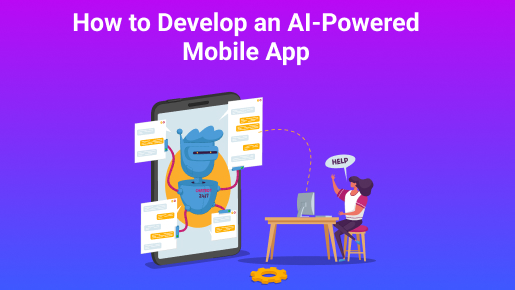Artificial Intelligence has become an important part of modern enterprise applications. From enhancing customer experiences to automating operations, AI-powered mobile apps are helping organizations gain a competitive edge. But building such apps is not a straightforward process.
It requires strategic planning, the right technology stack, compliance with data regulations, and choosing the right mobile app development company in the USA.
In this blog, we’ll walk you through an AI-powered mobile app guide for your enterprise, including:
- Key development steps
- AI technologies and platforms for mobile app development
- Cost estimation
- Compliance requirements
Why Enterprises are Investing in AI Mobile Apps
Before diving into the how-to, let’s quickly understand the benefits of AI in developing a mobile app. AI integration with mobile apps offers enterprises:
- Personalized user experiences
- Advanced analytics and business intelligence
- Automation of repetitive tasks
- Predictive insights for better decision-making
- Enhanced security with behavior-based detection
Whether you’re building a customer-facing app or an internal enterprise tool, AI can drive innovation and efficiency on a scale.
Step-by-Step AI-Powered Mobile App Development Guide
Here are a few simple steps to develop an AI-powered mobile app:
Step 1: Define Your Business Objective
Start by asking: What problem is your app solving? Your AI strategy should align with specific business goals such as improving customer engagement, automating customer service, or forecasting inventory needs.
Example Use Cases:
- AI chatbot for real-time customer support
- Image recognition for quality control in manufacturing
- Predictive analytics for retail demand planning
Define KPIS (Key Performance Indicators) early in the process to measure success later.
Step 2: Conduct a Feasibility Study
Evaluate whether mobile app development with AI is the right solution for your use case. This includes:
- Assessing data availability and quality
- Budget and resource planning
- Market research to identify user expectations
- Legal and compliance considerations
A feasibility study helps you determine if you need machine learning (ML), natural language processing (NLP), computer vision, or other AI subfields.
Step 3: Choose the Right AI Technologies and Platforms
Here’s a breakdown of the core technologies and platforms you might use to deliver mobile app development with AI:
AI Technologies
- Machine Learning Frameworks: TensorFlow, PyTorch, Scikit-learn
- Natural Language Processing: OpenAI & Google Dialogflow
- Computer Vision: Opencv, Amazon Rekognition, Google Cloud Vision
- Speech Recognition: Google Speech API, Amazon Transcribe
AI Tools for Mobile App Development:
- iOS Development: Swift, CoreML (Apple’s ML framework)
- Android Development: Kotlin, ML Kit from Google
- Cross-Platform Framework: Flutter and React Native with AI model for app development
Cloud Platforms for AI Services
- AWS AI Services: SageMaker, Rekognition, Lex
- Microsoft Azure AI: Cognitive Services, Azure ML
- Google Cloud AI: Vertex AI, AutoML, Dialogflow
Step 4: Gather and Prepare Your Data
Data is trained on AI models. Data gathering and preprocessing include:
- Collecting historical user data, transaction logs, images, audio, etc.
- Cleaning and labelling data
- Ensuring data is unbiased and representative
- Dividing data into training, validation, and testing sets
For enterprises lacking quality data, consider using pre-trained models or data from third-party providers (with legal clearance).
Step 5: Develop the App Architecture
Another step you need to include in mobile app development services is building the app layout. Design the app architecture keeping AI requirements in mind. A typical AI-powered mobile app architecture includes:
- Frontend (user interface): Built with Flutter, Swift, or Kotlin
- Backend: Hosted on AWS, Azure, or GCP
- AI/ML Module: Hosted in the cloud or embedded using edge AI
- Data Storage: SQL/Nosql databases, Data Lakes
Make the app modular, so AI features can be updated independently without affecting the entire app.
Step 6: Train and Integrate AI Models
At this stage, your data scientists or AI engineers will:
- Select the right algorithm (e.g., regression, classification, clustering)
- Train the model using prepared data.
- Optimize models using hyperparameter tuning.
Once trained, the models are integrated into the mobile app using APIs or embedded inference engines like TensorFlow Lite or CoreML.
Step 7: Test the AI-Powered Mobile App
AI apps need more than traditional QA. You’ll need to perform:
- Functional Testing: Ensure basic features work as expected
- AI-Specific Testing: Validate model predictions, bias, and accuracy
- Security Testing: Data security with AI protects your data from leakage and adversarial attacks
- Performance Testing: Measure response time, latency, and scalability
- Usability Testing: Ensure a smooth UX around AI features
Continuous testing and retraining are necessary, especially for apps that learn over time.
Step 8: Ensure Regulatory Compliance
When it comes to build an AI-powered mobile app, complying with data protection standards plays a vital role:
Key Compliance Standards
- GDPR Compliance: Data privacy and user consent
- CCPA (California): Consumer data rights
- HIPAA (USA): Healthcare data privacy
- ISO/IEC 27001: Information security standards
Incorporate features like data anonymization, user consent forms, and opt-out options to meet legal standards.
Step 9: Deploy and Monitor
Once your app is ready, deploy it to app stores or internal enterprise environments.
Use AI Ops and monitoring tools to:
- Track app usage and AI performance
- Detect anomalies or drifts in model accuracy.
- Collect feedback for continuous improvement.
Regular updates and retraining loops are essential for maintaining performance and relevance.
Cost to Implement an AI-Powered Mobile App
Cost of implementing AI in mobile apps varies based on complexity, features, and data availability. Here’s a rough breakdown:
| Complexity | Estimated Cost | Timeline |
| Basic AI (chatbot, recommendations) | $40,000–$70,000 | 2–4 months |
| Moderate AI (image recognition, sentiment analysis) | $70,000–$125,000 | 4–6 months |
| Advanced AI (custom ML models, NLP) | $125,000–$300,000+ | 6–14 months |
Additional cost factors:
- Licensing for AI APIs or SDKs
- Cloud infrastructure
- Data storage and processing
- Compliance and security integrations
How to Choose the Right AI Mobile App Development Company
Here are a few factors you need to consider to find the right partner with expertise in AI technology:
- AI-Powered Mobile Expertise: Proven experience in both domains
- Pre-vetted AI developers: Hire pre-vetted data scientists, AI engineers, and app developers
- Domain Knowledge: Understanding of your industry’s use cases and compliance needs
- Cloud & DevOps Experience: For deploying and maintaining scalable AI apps
- Transparency: Clear timelines, cost estimates, and communication practices
Ask for case studies, client references, and technical capabilities before finalizing a partner.
Read More: Exploring Diverse Dimensions: Mobile App Development Insights Across Industries
Final Thoughts
AI-powered mobile apps have become a strategic imperative for enterprises seeking to enhance operations, improve user experiences, and drive innovation. But success lies not just in adopting AI—it lies in adopting it the right way.
By following this AI-powered mobile app development guide, using the right technologies, staying compliant, and working with the right development partner, your enterprise can build a future-ready, intelligent mobile application that delivers measurable business impact.



